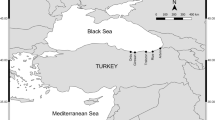Abstract
The common soleSolea solea Linnaeus, 1758 was collected from the Ebro Estuary each month (January–December) throughout 1987. The compostion of its natural diet was examined, and the possible influence of sex and age on prey selection. The contents of 461 stomachs were analyzed by means of frequency of occurrence, numerical abundance and Simpson's prey-dominance index in order to determine the dominant, occasional or accidental prey categories; 43 different families of prey were classified. Crustaceans comprised 54.9%, polychaetes 34.1% and molluscs (10.9%) of its diet. Significant differences in the basic diet were observed as a function of sex and age. Examination of the contents of the alimentary tracts revealed that males and females have different diets even when sharing the same habitat. The age-class groups also have different diets, smaller prey being replaced by increasingly larger food items with increasing age (size).
Similar content being viewed by others
Literature cited
Braber, L., de Groot, S. J. (1973). The food of five flatfish species (Pleuronectiformes) in the northern North Sea. Neth. J. Sea Res. 6: 163–172
Clark, M. R. (1985). The food and feeding of seven fish species from the Campbell Plateau, New Zealand. N. Z. JI mar. Freshwat. Res. 19: 339–363
Dodson, S. I., Egger, D. L. (1980). Selective feeding of red phalaropes on zooplankton of Arctic ponds. Ecology 61: 391–403
Lagardère, J. P. (1987). Feeding ecology and daily food compositon of common soleSolea vulgaris Quensel juveniles on the French Atlantic coast. J. Fish Biol. 30: 91–104
Main, K. L. (1985). The influence of prey identity and size on selection of prey by two marine fishes. J. exp. mar. Biol. Ecol. 88: 145–152
O'Brien, W. J., Slade, N. A., Vinyard, G. L. (1976). Apparent size selection as the determinant of prey selection by bluegill sunfish (Lepomis macrochirus). Ecology 57: 1304–1310
Pielou, E. C. (1966a). Species diversity and pattern diversity in the study of ecological succession. J. theor. Biol 10: 370–383
Pielou, E. C. (1966b). The measurement of diversity in different types of biological collections. J. theor. Biol. 13: 131–144
Protasov, V. R. (1970). Vision and near orientation of fish. Israel Program for Scientific Translations, Jerusalem
Quiniou, L. (1978). Les poissons démersaux de la baie de Dourarnenez: alimentation et écologie. Thèse 3ème cycle. Université de Bretagne Occidentale, Brest
Ramos, J. (1981). Régimen y comportamiento alimentario del lenguado (Solea solea L.) (Pisces, Soleidae) Infmes téc. Inst. Invest. pesq. 83: 3–15
Reys, J. P. (1960). Etude de la nourriture de quelques poissons démerseaux du golfe de Lion. Recl. Trav. Stn mar. Endoume 33: 65–97
Ruiz, J., Jover, L. (1981). Sobre la alimentación otoñal de la garcilla bueyera—Bubulcus ibis—en el delta del Ebro, Taragona. España. Publnes Dep. Zool. Univ. Barcelona 6: 65–72
Ruiz, J, Jover, L. (1983). Tipificación trófica de poblaciones mediante estimas de la dominancia y la diversidad. Trans. 15th int. Congr. Game Biol. 695–707. (Sevilla)
Shoener, T. W. (1971). Theory of feeding strategies. A. Rev. Ecol. Syst. 11: 369–404
Sorbe, J. C. (1972). Ecology et étolo ie alimentaire de l'ichthyofaune chalutable du plateau cotinentale Sud Gascogne. Thèse 3ème cycle. Université Aix-Marseille
Steven, G. A. (1930). Bottom fauna and the food of fishes J. mar. biol. Ass. U.K. 16: 677–706
Vinyard, G. L. (1980). Differential prey vulnerability and predator selectivity: effects of evasive prey on bluegill (Lepomis macrochirus) and pumpkinseed (L. gibbosus) predation. Can J. Fish aquat. Sciences 37: 2294–2299
Yinyard, G. L, O'Brien, W. J. (1976). The effects of light and turbidity on the reactive distance of bluegill sunfish (Lepomis macrochirus). J. Fish Res. Bd Can. 33: 2845–2849
Werner, E. E., Hall, D. J., Laughlin, D. R., Wagner, D. J., Wilsmann, L. A., Funk, F. C. (1977). Habitat partitioning in a freshwater community. J. Fish Res. Bd Can. 34: 360–370
Zaret, T. M. and Kerfoot, C. (1975). Fish predation onBonsomine longirosissis: body size selection vs. visibility selection. Ecology 56: 232–237
Author information
Authors and Affiliations
Additional information
Communicated by J.M. Pérès, Marseille
Rights and permissions
About this article
Cite this article
Molinero, A., Flos, R. Influence of sex and age on the feeding habits of the common soleSolea solea . Mar. Biol. 111, 493–501 (1991). https://doi.org/10.1007/BF01319423
Accepted:
Issue Date:
DOI: https://doi.org/10.1007/BF01319423




